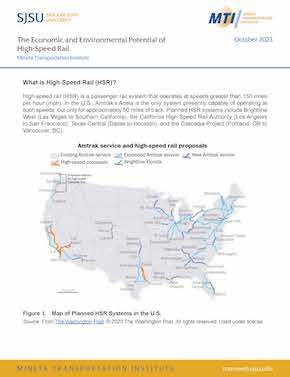- 408-924-7560
- mineta-institute@sjsu.edu
- Donate
The Economic and Environmental Potential of High-Speed Rail
High-speed rail (HSR) is a passenger rail system that operates at speeds greater than 150 miles per hour (mph). An increasing number of studies suggest that HSR could have many economic and environmental benefits for the U.S. This perspective outlines these potential benefits, which include job growth and increased economic activity; creation of an entirely new domestic manufacturing base; station area development and improved regional connectivity; and reduced GHG emissions and better land use. Additionally, a shift to HSR from other modes of transportation could help the public sector save money by reducing the need for highway, airports, and other infrastructure improvements. In the U.S., Amtrak’s Acela is the only system presently capable of operating at such speeds, but several HSR systems are in progress or in the planning stages. These include Brightline West (Las Vegas to Southern California), the California High-Speed Rail Authority (Los Angeles to San Francisco), Texas Central (Dallas to Houston), and the Cascadia Project (Portland, OR to Vancouver, BC). This paper provides critical insight into the impacts of these and future HSR projects, which along with research and policy, can help the U.S. leverage these potential benefits.
Mineta Transportation Institute is a University Transportation Center sponsored by the US Department of Transportation, the California Department of Transportation, and public and private grants, including those made available by the Road Repair and Accountability Act of 2017 (SB1). The Institute is part of San José State University’s Lucas Graduate School of Business.
-
Contact Us
San José State University One Washington Square, San Jose, CA 95192 Phone: 408-924-7560 Email: mineta-institute@sjsu.edu






